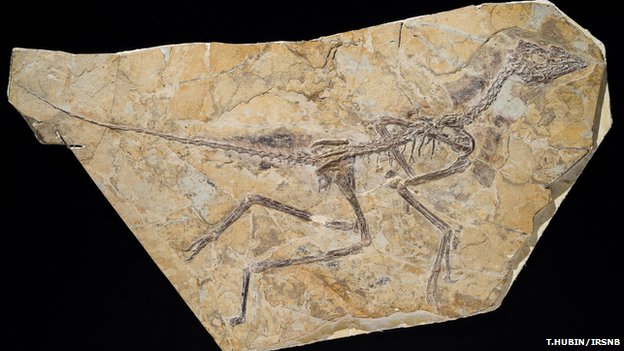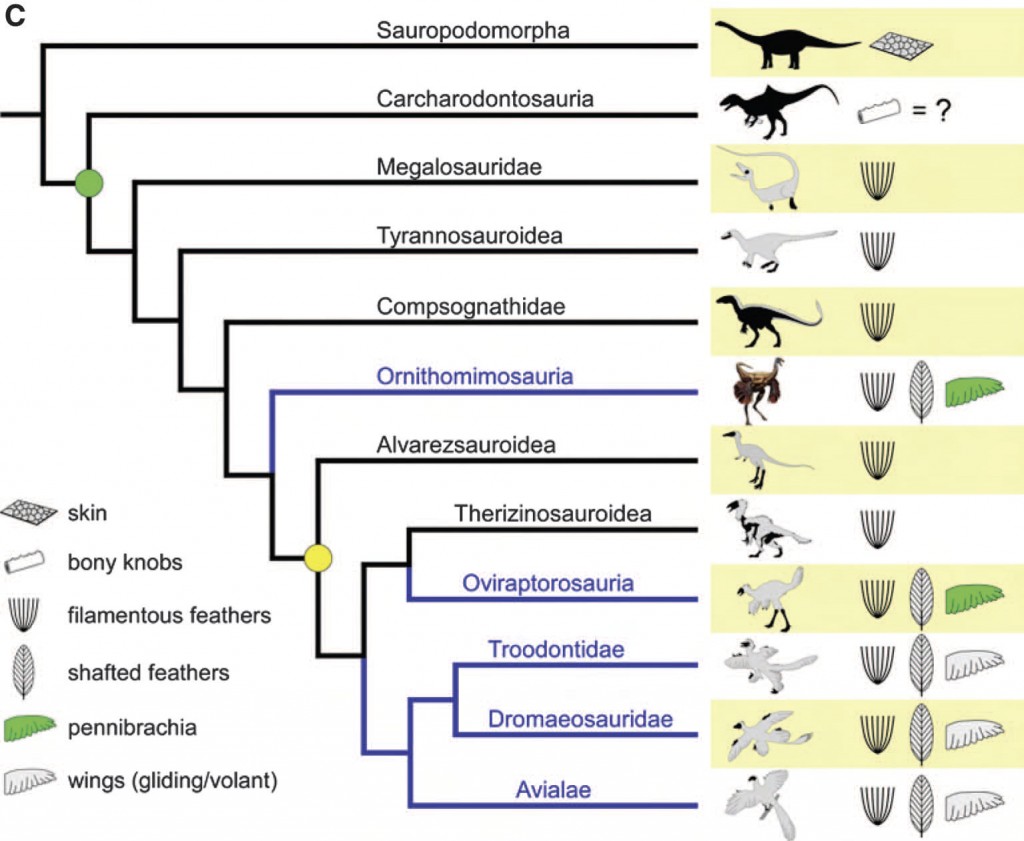May 30 2013
Yet Another Fossil Bird – Aurornis xui
 Keeping with the recent discussion of the evidence for evolution, I want to discuss another well-preserved fossil bird from the Liaoning Province in China – Aurornis xui, or the dawn bird. As the name implies, this fossil represents what is now the most basal species on the branch that diverted from other dinosaurs and ultimately led to modern birds.
Keeping with the recent discussion of the evidence for evolution, I want to discuss another well-preserved fossil bird from the Liaoning Province in China – Aurornis xui, or the dawn bird. As the name implies, this fossil represents what is now the most basal species on the branch that diverted from other dinosaurs and ultimately led to modern birds.
Before I get into the details of this new fossil, let me go over some background, and the implication of these finds for the theory of evolution.
When Darwin proposed his theory in 1859 the fossil record was scant. Already at that time, however, there were enough fossils for geologists to have recognized a pattern – different geological strata contain different assemblages of fossils. They seem to change, or evolve, over geological time. Fossil species do not all arise at one, they are not randomly placed, nor are they the same throughout geological time – they profoundly change.
Still, when Darwin made evolution the accepted scientific theory, the fossil record was relatively sparse, and one of the major predictions of evolutionary theory is that scientists will continue to discover fossil species and they will fit into a generally evolutionary pattern. A single fossil demonstrably out of evolutionary sequence could falsify the theory, or at least require a major revision or addition of a new fundamental element.
It’s important to note at this point that we must distinguish the basic fact of evolutionary change over time and common descent from the details of what evolved from what, and the pattern of change over time. The fossil record was insufficient in Darwin’s time to draw a clear picture about the details of evolutionary history. It is therefore not proper scientific reasoning to argue that errors over the details call into question the bigger picture of common descent and change over time.
In other words – evolutionary theory does not require that birds evolved from dinosaurs, but it does require that birds evolved from something and that we can see the anatomical and temporal relationships.
The existence of major groups, like birds, without extant species that provide an obvious connection to a distinct but closely related group provided a great test for the theory of evolution. Such gaps are true of all living species, the only difference is the size of the gaps. Birds are a large group, and their next closest living relatives, reptiles, are quite different. That’s a huge gulf.
Evolutionary theory demands that birds had to evolve from something, and the most likely candidate is a common ancestor with their most closely related cousins. Evolutionary theory therefore predicted that we would find fossils that fill the morphological space between birds and reptiles, and in a proper temporal sequence (the exact group of reptiles, at the time, to be determined).
The first fossil to fulfill this prediction was Archaeopteryx. It remains a stunning example of a fossil species that is transitional between two major groups – birds and theropod dinosaurs. It not only provided the “missing link” between birds and reptiles, but fairly solid evidence that birds evolved from dinosaurs. Archaeopteryx has a pretty even mix of dinosaur and bird features, with some primitive bird features. It could fly, but not well.
For decades, however, the few specimens of Archaeopteryx were seen by critics of evolution (and proponents of alternate theories of bird evolution) as a fluke, a curious side branch or strange creature that does not provide definitive evidence for the evolution of birds from dinosaurs. Fair enough, if birds did evolve from dinosaurs then more evidence would likely resolve the dispute.
Then paleontologists started finding the remains of early birds and feathered dinosaurs in the Middle–Late Jurassic Tiaojishan Formation of Liaoning Province. This formation provided a window into the right place and time to see the evolution of birds happening. Over the last two decades many feathered dinosaurs and early birds have been discovered, filling in the morphological space between birds and theropods, and also demonstrating that theropods were even more bird-like than previously believed. Many classic dinosaurs, like velociraptor known from the movie Jurassic Park, are now known to have had feathers.
The picture that has emerged is consistent with the overall picture of evolutionary change that has emerged from the fossil record over the last 150 years. At first scientists naively thought of evolutionary change as a ladder. The infamous display of horse evolution as if it were a straight line from eohippus (that’s right, I said it, hyracotherium be damned) to modern horses is a good example. Rather, evolution proceeds more like a complex bush with adaptive radiation.
Within our current understanding of the pattern of evolutionary change over time we expect to see a complex bush of adaptive radiation of feathered dinosaurs and early birds, with only one branch out of many leading to modern birds. That is exactly what we find, and of course scientists are still working out the details from incomplete evidence, with each new fossil species redrawing the lines to some extent.
Enter Aurornis xui. This is not just another fossil early bird, but so far it is likely the earliest bird – the most basal specimen on the branch that led to modern birds. The specimen has been analyzed in detail, with 1,500 features described and compared to other paraves specimens (paraves refers to the various lines of feathered dinosaurs that include birds and their close relatives). The authors summarize the implications of this new specimen:
Including this new taxon in a comprehensive phylogenetic analysis for basal Paraves does the following: (1) it recovers it as the basal-most avialan; (2) it confirms the avialan status of Archaeopteryx; (3) it places Troodontidae as the sister-group to Avialae; (4) it supports a single origin of powered flight within Paraves; and (5) it implies that the early diversification of Paraves and Avialae took place in the Middle–Late Jurassic period.
Pretty cool. It simplifies the picture of bird evolution – requiring that flight only evolved once. I also love the fact (this is just a personal bias) that it restored Archaeopteryx to the bird line, as I have a particular fondness for that specimen.
Archaeopteryx is now on the Avialae line. As you can see from the cladogram, there are other paraves lines that did not lead to birds, and feathers go back even further (we are still not sure exactly how far – new specimens with preserved feathers keep pushing back the origin of feathers in the dinosaur clade).
This is all a stunning confirmation of evolutionary theory. Only common descent predicts that we must find fossils that connect birds to their closest living group, reptiles, in a proper temporal sequence. There is no rational argument against the obvious conclusion that this assemblage of fossil birds and feathered dinosaurs is the smoking gun of evolutionary change, specifically that of birds from theropod dinosaurs (although that does not stop creationists).
Nothing short of blatant pseudoscientific denialism can deny the implications of these fossils, and we keep discovering more. The Tiaojishan Formation is not done producing new specimens and filling in the picture of bird evolution.
This same story has also been played out for many other modern groups and species. Fossils discovered since Darwin have filled in the morphological space (always in a proper temporal sequence) between modern humans and our ape ancestors, between whales and terrestrial mammals, between mammals and reptiles, and countless other groups.
Take the evolution of birds from dinosaurs and multiply that by a thousand, and that is the mountain of fossil evidence on which the theory of evolution rests. And that is just one line of evidence, which we can add to the genetic, developmental, biological, geographic, and molecular evidence.
At the risk of beating this dead horse – this is anything but weak evidence. It is rock solid strong evidence, making evolution scientifically undeniable.







